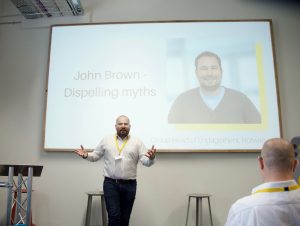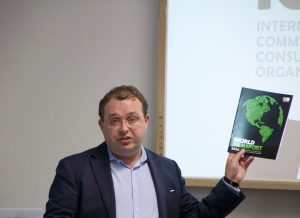Dispelling Integrated Comms Mythology
Let the fun and games commence on Day 2 of PRFest 2017, with John Brown from Hotwire PR first up. Mr. ‘Use Your Common Sense When Doing Integrated Comms’ – John dispels the myths surrounding integrated comms. See John’s slides here (although they won’t make much sense without the narrative below!)
An Early Disclaimer
Brown has a low tolerance for BS, not to mention made up words and concepts. The term ‘Integrated Comms’ (IC) is the latest PR buzzword, and honestly, no one really knows what it is or whether they are doing it properly. IC is just a whole load of hearsay.
Myth 1 – Media Relations is bad
Media relations can’t be bad in itself. In fact, it can be a tasteful and extraordinary way to achieve fast results. This is a priority area and should be used well as it’s absolutely a measurable outcome. When used well, it’s actually pretty damn good.
However, there is a darker side to media relations. The problem lies in it being a tactic rather than a strategy. So when entering the planning stage, do so with an open and empty mind, so as to avoid the pitfalls of pre-prescribing an answer we don’t yet know the question to.
 Myth 2 – Digital is good
Myth 2 – Digital is good
We are living in an era where digital comms is taking a bit of a battering. 42% of people want to see face-to-face events or live interactions when asked about what experiences they look for in content.
A human-to-human first approach is therefore fundamental. We should be looking to mimic a human experience to connect us in real human terms. Digital can be good, but face-to-face will always trump other forms of communication.
Myth 3 – Everything has to lead to an action
It can build up and up but we don’t always need to agonize about the audience. This trail of thought is more of a barrier or hindrance when believing that every step must lead to an action.
The Lego Movie in 2014 is a winning example of putting entertaining people first. By spending $50 million entertaining people, they generated $4.9 billion worth of sales. Since this success, building trust and loyalty by entertaining first has become a leading mantra in their company philosophy.
Myth 4 – We must take our audience on a journey
These journeys do not have to be long. Why create a long-winded marketing journey when a really short A to B is the best strategy? As long as there is real purpose behind it, there really is no need. By shortening an audience’s journey, you are giving yourself more time to be impactful and smarter.
Myth 5 – Using paid is cheating
It’s wicked, but why?
If a person takes a brand name or maybe even a product, what are they going to do to find out more? Google it. In this case, PPC and paid advertising then really becomes effective and not a bad practice.
Myth 6 – It’s all about marketing
True integrated campaigns focus on integrating the company and working together. The departments you bring in are just as important as those media channels used. Everything will work seamlessly if this is achieved in harmony.
Myth 7 – Video is a must
To be clear, video is a superb media. However, there is a problem. Everyone has a video inside of them and for some people that is where it should stay…
The three musts of video are insight, the idea and the execution, and there is a graveyard out there littered with corporate videos that didn’t combine these crucial elements. Warning: Video is expensive and damaging if you get it wrong.
Myth 8 – Everyone else is doing it
People are really not doing Integrated Comms that frequently. Fact.
Myth 9 – Twitter research rules
Don’t take one sample size from one platform. Go back to basics and utilise small focus groups because it’s more important to go to a CFO with relevance and context provided by actual consumers.
Social does not show real life and is biased towards a sample size. To combat this, this needs to be complimented with context and quantitative research.
Myth 10 – Your message counts
Tone and personality are what people are buying from a brand or individual. The message can come later. So you are better off spending time investing in identifying a personality, as that will help gel a campaign together.
Myth 11 – Sensitive emotion is key
Be very careful here. Very few storytelling and brands can do this well.
Myth 12 – Plan, Plan, Plan
Getting your ethos and purpose right first will allow you to be agile and reactive, as well as proactive, later. Don’t be afraid to allocate a small test budget first to get the ball rolling.
Do you have a seat in the ’war room’?
 Amanda Coleman, Head of Corporate Communications at Greater Manchester Police, was confirmed as a speaker at PRFest late last year, to talk about crisis communications. Little did we know what would happen in Manchester on 22 May, just weeks prior to PRFest.
Amanda Coleman, Head of Corporate Communications at Greater Manchester Police, was confirmed as a speaker at PRFest late last year, to talk about crisis communications. Little did we know what would happen in Manchester on 22 May, just weeks prior to PRFest.
We would like to offer our thanks and gratitude to Amanda Coleman, who a) used the attacks as an example in her presentation, expertly discussing scenarios, planning, what her team were doing in the midst of a national atrocity and b) most importantly, all of the ‘human’ elements of being in and dealing with a major crisis situation, including the way it affected her, personally.
Amanda dealt with the sensitive and emotive nature of the topics discussed with poise and dignity and PRFest thanks her for taking the time to re-write her presentation so it was bang up-to-date and for using one of her only days off to come to PRFest and tell us her story.
Due to the nature of the event we have not added Amanda’s presentation to our Slideshare and we have left out sensitive information in the round-up blog post.
Raw emotional response
The past four weeks following the Manchester Arena terrorist attack have been “really odd” and understandably so. They really illuminated why planning is so important, given the highly sensitive nature of this event. It also highlighted that to combat such a crisis you really need to have the full trust of the organisation. That way you will sit next to the key people in the ‘situation room’ in order to give the right advice, help make the best decisions and to get things done quickly and effectively.
Amanda told us that her comms team pulled together, acted with integrity, compassion and empathy and she was grateful she had them to work with.
Operational response
The sequences of events that follow an incident all occur within minutes.
Incident occurring > Informing the media > Updating the media
Alternatively, following a major incident, inaccurate or false claims can equally spread like ‘fake news’ wildfire.
 Comms response
Comms response
There is a real need to understand the ‘mood’ because this heavily impacts on what you deliver or release into the press and wider public domain. The ‘golden hour’ for communication responses is now more like 30 minutes, proving speed is critical to coordinate agencies and implement team plans.
Never underestimate the importance of correctly reacting to the community side – the human side. We need to work harder to help those people who are impacted and living with the consequences. The perspective post Manchester has shown communicators do not think about them enough during a crisis.
Making families the priority and center of everything should be your main focus. We need to share in a crisis, creating agendas that involve family aftercare plans. There is a real need to share our learnings and this concept nationally, for all police forces to implement.
Role of the Media
Media engagement is vital as this helps set the narrative or tone of your crisis response. Everybody has a view on everything nowadays, from citizen journalists to bloggers, so be aware of immediate analysis and responses to your outputs.
International media have different roles and operate differently. You need to accept that rather than controlling content, now it’s all about coordination.
Handling the Manchester Terror Attack
The Comms team responded by sending out their first tweet within 20 minutes of the incident. This immediately recognised the issue, whilst serving to preserve and protect life by keeping people away from the area.
The next step was to start their plan and investigation phase. Further family support was implemented and Greater Manchester Police were on camera just four hours after the incident took place.
There are so many teams and people to consider in a time of crisis, internally. Where are they? Is anyone on holiday? Can any additional resource be brought in?
In times of crisis the comms team pulls together and works all the hours they need to ensure they are handling and managing the situation.
Dealing with the Legacy
Comms will always be dealing with the legacy of this horrific terrorist attack, so we need to start planning now.
Remember the key elements learnt here:
- Putting victims and their families at the center
- Honest and accuracy of information outputs
- Understanding the mood or tone
- Maintaining a regular flow of information
- PLAN AND PREPARE
**Cue standing ovation**
Trends, Challenges & Opportunities in Global PR
We were joined by the main sponsor of PRFest and PRCA Director General, Francis Ingham, to conclude our morning session, for a data-driven treat on what challenges and opportunities the global PR industry faces.
Follow the presentation slides here.
The Bigger Picture
The International Communications Consultancy Organisation, (ICCO), has gathered detailed survey information from 55 countries to establish global trends in conjunction with PR Week magazine. They have been producing this magazine for over 15 years to track industry trends across the globe.
The surveys highlighted where areas of industry optimism are highest in Western Europe, compared to at their lowest in Africa and Latin America. Similarly, industry confidence in profitability is strongest in North America and closely followed by the UK, whereas Latin America is showing the least confidence levels.
Two Big Global Headlines
- The industry is optimistic.
- The industry is profitable.
 What is driving growth?
What is driving growth?
CEOs are increasingly valuing corporate reputation, which pushes PR to the forefront of any organisation. Also, marketing spend is moving over to PR agencies who are offering more non-traditional services to clients. The expectation here is for these trends to continue to progress positively in the future. There lies the opportunity.
What is growing?
Practice area growth in 2016:
- Digital and online
- Corporate reputation
- Marketing
- Public affairs/government relations
Identical growth in digital/online is forecasted for next year, whilst public affairs are predicted to overtake marketing comms in practice area growth.
Tech and consumer came top in sector area growth in 2016, whilst next year’s predictions suggest healthcare will overtake tech.
Industry Problems
In a growing and vibrant industry, densely populated with talented people, staff retention and recruitment where the biggest recorded issues. Talent is a global issue and the key issue in the UK, and if we don’t face up to it we will decrease the value of our industry.
Our To-Do List
- Retain key talent
- Find people from non-traditional backgrounds
- Start hiring senior staff
- Begin training and develop junior/mid-level employees
What are the skills of the future?
Clear trends point towards social media management skills, so follow our To-Do List to begin plugging the existing gap in PR talent skillsets.
